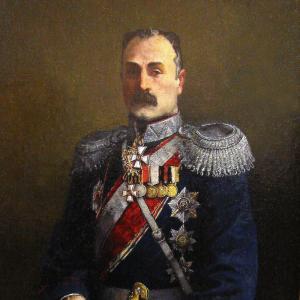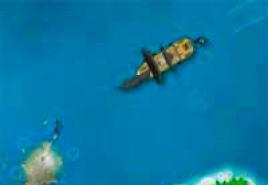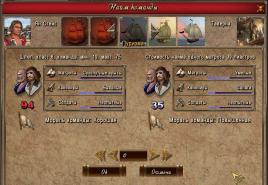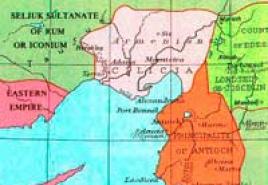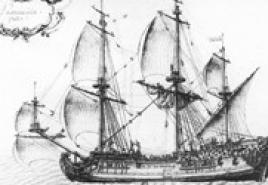Who is a Cossack ataman and how does he differ from an ordinary person? The meaning of the word ataman Ataman etymology.
In the photo: Vladimir Panteleimonovich
Veklenko - ataman of Tambov
separate Cossack society
Ataman is an elected leader in the Cossack community, a leader, a worthy Cossack who has shown personal valor and glory. The ataman is the highest commander of the Cossack army (depending on the form of performance of duties - military, marching, command, koshev) or the head of the Cossack administrative-territorial unit (district ataman, department ataman, stanitsa or farm ataman). Also, the commander of a military unit or any armed detachment was appointed ataman.
The word "ataman" has several versions of origin:
1. “Ata” is translated from Turkic as “grandfather”, “man” in translation means “I”. If you combine the two meanings, you get “I am the eldest.” It can also be translated from Turkic as “elder of a thousand,” given that the word “men” means “thousand.”
2. “At” in the Tatar language means “father,” “aman” means “with a horse” or “on a horse.” Consequently, from Tatar “ataman” is translated as “father on horseback.”
3. Amtman is a German word meaning chief of service or head of office.
4. “Odaman” in Kumyk means “master”, “chief”. The word “oda” in the Kumyk language means a large house, yard or family. Consequently, the “ataman” is the “chief in the family.” When the shepherds formed a nomadic camp (kosh), they chose an ataman for themselves. The Cossacks also have a “koshevoy ataman,” which confirms this version of the formation of the word “ataman.”
5. The Goto-Germanic, or Asalan, version is the most common. According to this version, the word atta means “father”, and the word mann is translated as “husband” or “knight”. And now the Cossacks call the ataman “father” or “father,” which not only reflects the role of the ataman in Cossack society, but also serves as a reminder of a certain layer of the historical and cultural heritage of the Russian people.
Historically, the word “ataman” was mentioned back in the 14th century on the pages of the Lithuanian Chronicle. At that time, the Cossacks, together with the Lans and Goths, formed the squad of the Crimean Khan. Ancient acts from Crimean history mention “Ataman Duvan”, and from the middle of the 16th century the word “Ataman” began to be mentioned in various sources related to the Cossacks.
The Cossack ataman had executive and judicial powers, occupying a military-administrative position. The activities and functions of the ataman depended on the historical period and the goals set. For example, for campaigns, military operations or for serving outside the troops, a marching ataman was elected, and atamans of light and winter villages were appointed to perform diplomatic or representative functions; they were considered the heads of embassies. The military ataman was elected the main leader of the troops. In the absence of a military ataman, the functions were transferred to the ataman. There were also atamans of kurens (kuren atamans), Lisitsky atamans (responsible for hunting), krany atamans (responsible for trade), koshevye, regimental, stanitsa, farm, and district atamans. The leader in any business could be called an ataman; for example, the head of a fishery on the Ural River was called a fishing ataman. In the coastal fishing artels, an ataman (vatamman) was elected, who was the main manager of the work, the head of the fishing party. Such atamanism is mentioned in the Novgorod charters of the 13th century. In Little Russia and Novorossiya, ataman was the name given to the village foreman and other experienced, authoritative elders in various areas of activity.

The chief leader of the entire army was called the military chieftain. He was elected by the military circle. The position of military chieftain was elective until 1718, then the military chieftain was appointed by the government, and the election of chieftain among the Cossacks was abolished. Military atamans carried a “nasek” (cane) in their hands, which they then handed over to the newly elected one. Peter the Great decided to give the military chieftains a special status and in 1704 granted the Don Army a decorated insignia with the inscription “Insect of the Don Army of 1704.” and a silver seal. In 1705, Peter I granted the military atamans a pernach, gilded with silver and decorated with precious stones, as a sign of their dignity.
In Ukraine, the military ataman was called the hetman. The chieftain of the Zaporozhye Sich, who was also elected, was called the koshev chieftain and reported directly to the hetman. The Zaporozhye Sich was divided into kurens, and, accordingly, there were kuren atamans (in the modern sense, the commanders of individual units of the army).
From October 2, 1827, the heir to the throne became the august ataman of all Cossack troops, and the Cossack troops were controlled by appointed atamans.

After the events of 1917, the status of military chieftains was restored. Throughout the Civil War, the military atamans of the Cossack troops were not only talented military leaders, but also a shining example of heroism and courage in the fight against the Bolsheviks and against the “Red Terror.” Observing loyalty to the oath taken for the Faith, the Tsar and the Fatherland, the Cossacks, led by military atamans, shed blood and performed feats that were included in the glorious history of the Cossacks.
Since the 1990s The revival of the Cossacks began, and the institution of military atamans was restored. At the moment, military atamans are appointed by decree of the President of the Russian Federation.
The procedure for electing an ataman
The ataman is chosen in a circle by an open vote of the Cossacks. Candidates for atamans sit bareheaded next to the priest. They vote for each candidate separately, before voting, the candidate for atamans goes to the middle of the circle, bows to the cross, the priest, then the old people and Cossacks, reads out his program, and then the Esau resident asks those present: “Gentlemen, honest Cossacks, do you like such and such ataman?” The candidate who gets the most votes becomes the Ataman.
In the Cossack tradition, it is believed that at the moment of the oath, the new ataman receives special power. To take the oath, the chosen ataman is led by two bailiffs, holding hands. According to tradition, it is not permissible to touch the chieftain’s cheek or bare arm with his bare hand, so that the new chieftain does not lose strength. To do this, the bailiffs hold the chieftain by the sleeves above the elbow, and the chieftain puts his hands on the bailiffs' cuff-covered wrists. The ataman's uniform is removed, his shirt is unbuttoned or torn to reveal the cross, a symbol of belonging to the Orthodox faith. The Esau resident exclaims: “Orthodox!” - and the Cossacks shout: “Lyubo!” and get up. The chieftain, facing them, says in complete silence:
“On the Life-Giving Cross of Christ, on the Holy Scriptures, I swear:
Serve faithfully, not sparing your head and belly.
Protect the Cossack honor.
Increase the wealth of the village.
Take care of the Cossacks!
I am your father. You are my children!
After pronouncing the oath, the ataman bows to the Cossacks and, led by the bailiffs, goes to the old men and makes a bow before them. The Cossacks and old men bow in response, and the bailiffs bring the ataman to the priest and lectern, he kisses the cross and the Gospel. After this, the bailiffs take the chieftain to the middle of the circle, and the elder whips the chieftain three times on the back with a whip.

The chieftain receives symbols of military and economic activity: a saber is put on him over his right shoulder, and a towel over his left, which symbolizes the cross - the protection of the chieftain’s activities by Christ.
The ataman receives from the senior in rank and age a pernach or mace, symbolizing military power. The old men present the ataman with a staff or insect, the Esaul man puts a hat on the ataman’s head and gives the command: “Hats off before the ataman!” Everyone who is of lower rank than the ataman takes off their hats. From this moment the oath is considered accepted. The chieftains, who are of lower rank, swear allegiance to the newly elected chieftain. All the Cossacks come up to the cross and the Gospel and kiss them. In this way, a new ataman is chosen, who will be responsible before the Cossacks and God for his actions and efforts for the benefit of the Cossacks.

Sayings:
They go from rank-and-file to atamans.
Be patient, Cossack, you will become an ataman.
It’s time for you to become ataman, there is someone older than you.
Without an ataman, a Cossack is an orphan.
The artel is strong with the ataman.
Without the ataman, the duvan is not blown, the spoils are not divided.
Don't chase a simple thief, but catch the chieftain.
Not the ataman with a mace, but the mace with the ataman, his power, will.
To be an ataman is to keep order.
Not all Cossacks can be atamans.
Wherever you turn your eyes, Ataman, we will turn our heads.
Igor Martynov,
military foreman, deputy ataman of the Tambov department
Cossack society
Who is an ataman and what is the meaning of the word “ataman” you will learn from this article.
Who is the ataman?
Ataman is official elected official in the Zaporozhye Sich during the 16th - 18th centuries. The ataman headed the entire Sich organization or a separate Military-administrative unit - the hut. If it happened that the ataman was not elected for certain reasons, but was appointed, for example, during a military campaign, then he was called a mandated ataman. In the Hetmanate during the 17th - 18th centuries, there were also positions of city, village and hundred atamans.
What does the word "ataman" mean?
The concept of ataman means “father of people” from the Turkic language. Nomads previously called this the oldest representatives of their clan. There is also another version, according to which the word ataman comes from the German word “Harter Mann”, which means “strong man”. Since the 16th century, atamans began to be called the elected or appointed leader of the Cossack army.
Ataman is elected person heading the hut. He was in charge of the management and facilities of the kuren, and resolved absolutely all issues relating to the life and everyday life of the Cossacks.
Who is a Cossack ataman and how does he differ from an ordinary person? Ataman. "Do not drift, Cossack, you will be the chieftain." Agree, this phrase is heard quite often, even by those who come into contact with the Cossacks, only when they see these gentlemen on TV. Although, it immediately becomes clear that being an ataman is a prize for courage, like being a deputy or being a director: drive your subordinates as hard as you can while you warm your sides in the Canary Islands... However, it’s not the same. Atamans in the past somehow did not strive for positions and did not go over the heads of other comrades, pushing them aside with their elbows. This post was especially life-threatening for some. When someone was called a dad, he automatically became, in the literal sense, the father of the people who placed their trust in him (both the executive and legislative branches rolled into one). And just try not to justify this trust! Sometimes they would chop with a saber. The ataman was re-elected very often, they say, once a year - such a manifestation of filial care, so that the authorities would not turn their heads and would not have to remove that same head from their shoulders. But those who showed themselves to be the best were often called “honorary chieftain” and he bore this title with dignity until the end of his days. And also... The proverb does not specify what kind of ataman one who is not drifting can become. They are different even in the same structure. For example, a military ataman is now a very cool gentleman who leads some kind of army: Kuban, Don... etc... in our case - Terek. But there are still a lot of others! For example, district or stanitsa: they are chosen at Krug by majority vote. Further more. Marching, punishment, koshev... and all the atamans! Only the functions are different for everyone, and also...they are not chosen, but assigned. Koshevoy is such a status of the main skeet, he is responsible for the satiety of comrades in the campaign ... although, and not only them. The duties of the ataman were to feed the horses and others, provide everyone with temporary lodging for the night and guard the camp. The ordered ataman is the cooler one. This could easily be the IO, left by the ataman to rule during his absence. As for the marching one, everything is more complicated here: it seems like he is responsible for drill, military and other training immediately before, after and during military operations. He makes sure that the gun shoots, and the saber cuts ... Oh, yes, there is one more post - the comrade of the ataman. Not “brother” or “buddy”, but comrade. Perhaps you even met somewhere such a phrase as “the first comrade of the chieftain” and did not understand anything. However, this is not a literary passage or a joke. This is a position! From now on, be savvy: we are talking about a deputy.
Cossack atamans were key participants in all wars of the Russian Empire. Their role is often underestimated, but the most important events in Russian history are associated with their names.
1. Ermak
Oh, despite the scale of this figure, we don’t know very much. We don’t even know the exact place of his birth. Ermak was in the popular consciousness a kind of semi-legendary character, a “people's protector.” In the Kungur Chronicle it is said about him that he robbed and plundered on the Oka in a crowd of 5,000 people, then on the Volga, already with 7,000 Cossacks, then he wanted to go to Persia...
We also don’t know how Ermak died. One thing is certain: there was no “chain mail or fur coat from the royal shoulder” on Ermak. Ivan the Terrible had previously granted Ermak cloth and gold, and ordered Ermak to return.
2. Mikhail Cherkashenin
Ataman Cherkashenin and his Cossacks made a huge contribution to the victory when the troops of Devlet-Girey were defeated. This was a key moment in Russian history - if Russia, weakened by the Livonian War and the plague, had lost, it would have changed the course of history.
Cherkashenin was one of the main atamans of the times of Ivan the Terrible; he participated in the defense of Polotsk and Pskov from troops. Legends arose about his bravery. It was believed that the chieftain was charmed by bullets, and even the chronicler wrote that he charmed enemy cannonballs. The chronicler wrote about the ataman’s death: “Yes, they immediately killed Mishka Cherkashenin, but he guessed to himself that he would be killed, but Pskov would be intact. And that’s what he told the governors.”
3. Kondraty Bulavin

Ataman Kondraty Bulavin was very dissatisfied with the fact that the Cossacks were forbidden to mine salt at the Bakhmut mines and with the fact that Peter I issued a decree on the forced return of fugitive peasants, so in 1707 he gathered an army and went to fight the tsar. The so-called “Bulavin uprising” lasted two whole years; in 1708, Bulavin was killed as a result of a conspiracy, but the uprising did not subside. Its leadership passed to Ignat Nekrasov.
4. Ignatiy Nekrasov

He accepted Bulavin’s leadership of the uprising and gathered a Cossack circle, but a unified decision on further measures was never made. Nekrasov’s troops were eventually defeated by the Tsar’s and he first, which at that time was on the territory of the Crimean Khanate, and then completely moved to Turkey.
The transition of the Ignatov Cossacks to Turkish banners was recorded by Pushkin: “Spears that they had never seen before were seen from the Turks; these spears were Russian: the Nekrasovites fought in their ranks.”
5. Yakov Baklanov

Cossack songs dedicated to Baklanov mention the “terrible Baklanov blow” - Yakov Petrovich was known for cutting a rider in half with a saber from the shoulder to the pommel of the saddle.
A hero of the Caucasian War, Baklanov was the first to make his personal banner a flag of black fabric, which depicted a skull with crossbones and a circular inscription from the “Creed”: “I look forward to the resurrection of the dead and the life of the next century. Amen". This banner had the most decisive effect on the mountaineers.
One of the eyewitnesses wrote: “Wherever the enemy saw this terrible banner, fluttering high in the hands of the giant Don, like the shadow of one following his commander, the monstrous image of Baklanov also appeared there, and inseparably with it was the inevitable defeat and death of anyone who fell on paths."
6. Naum Vasiliev
For Ataman Naum Vasiliev (Sheludyaki), we do not know either the date of birth or the date of death, but we know that he was the Ataman of the Don Army, in 1637 he participated in the capture of Azov, led its defense from the Turkish-Tatar troops and from time to time led forays . Sheludyak traveled to Moscow several times as an ataman of a Cossack village with the news that the Cossacks had retained Azov. In 1656, the ataman took part in the assault on Azov, but this time it was not possible to take it.
7. Ivan Galkin

Ivan Galkin was the founder of the Ilimsky, Ust-Kutsky and Barguzinsky forts.
Galkin can also be considered one of the founders of Yakutsk. Under him, on February 6, 1638, the Yakut Voivodeship, independent of the Yenisei Voivodeship, was established. Yakutsk received the status of capital for the first time.
8. Epifan Rodilov
Despite the fact that Epifan Rodilov was “removed” from the post of ataman several times, his fame thundered and he became an ataman again. He took part in several assaults on Azov, and in the spring of 1627, Rodilov led a naval campaign of a united detachment of Don and Zaporozhye Cossacks on the Turkish coast. A Cossack flotilla suddenly appeared in the vicinity of Istanbul. They burst into the Golden Horn Bay and set fire to the standing warships and merchant ships of the Turks. In the Turkish capital, the Cossacks “made a lot of noise,” after which they disappeared as quickly as they had appeared. But already in decent booty.
9. Zakhary Chepega

Zakhary Chepega, Cossack ataman of the Black Sea Cossack Army, was an unusual Cossack: he had a house, he had serfs, but Chepega rarely visited this house - he fought more and more. The Black Sea Cossacks under his command particularly distinguished themselves during the capture of Ochakov, the fortified island of Berezan, Gadzhibey, Akkerman, and Bender. In 1790, the Cossacks showed incomparable courage during the assault on Izmail.
Chepega also took an active part in the resettlement of the Black Sea Cossacks to the Kuban (to protect the border), and in the pacification of the Polish uprising of 1794. For the successful assault on the outskirts of Warsaw - Prague - Chepega he was awarded the Order of St. Vladimir 2nd class.
10. Mikhail Tatarinov
The name of Ataman Mikhail Tatarinov entered Russian history - under his leadership, the Don and Zaporozhye Cossacks besieged and took the Azov fortress in 1637.
About 4000-4500 people took part in this campaign (of which there were one thousand Zaporozhye Cossacks).
After the capture of Azov, Tatarinov asked the Moscow Tsar Mikhail Fedorovich to take the captured Turkish Azov under his authority, but the Tsar refused - he did not want a war with the Ottoman Empire. The Cossacks began the famous “Azov Sitting”.
11. Matvey Platov

Military ataman of the Don Army, count, cavalry general, hero of the War of 1812. The most famous ataman not only on the Don, but throughout Russia and in the world. Hero of Russian wars of the late 18th - early 19th centuries. It was Platov who led the Indian campaign conceived by Paul the First, it was Platov who subordinated all Cossack formations abroad during the war with Napoleon, it was Platov who went to London with the emperor to make peace.
The Don Cossack became a living legend for the British. Eyewitnesses of those events said that one day the crowd after the service carried Platov out of the temple in their arms and carried him all the way to the carriage. The ataman's visit to the theaters suspended the performance. Cossacks became fashionable in London, and the British began to call themselves that way. Including the famous Lord Byron once declared: “And I am a Cossack!”
12. Ivan Zarutsky
Zarutsky is a far from unambiguous figure in Russian history, but this makes him even more ambitious. He was the favorite of Marina Mnishek in 1608 - 1614 and the most likely real father of her son, Ivan False Dmitrievich Vorenok. It was he who Ivan Zarutsky saw on the Russian throne.
However, it didn’t work out. Zarutsky’s forces were not enough to provide worthy resistance in the Astrakhan Kremlin, and in May 1614, with Marina Mnishek and her son, he fled to Yaik, where he took refuge on Bear Island, but was captured there after the battle.
On July 6, 1614, Zarutsky was brought to Astrakhan, and from there, together with Marina Mnishek and her son, he was sent to Moscow. “In Moscow you put that Zarutskovo on a stake, and you hanged Vorenka, and Marina died in Moscow.”
13. Kornily Yakovlev
The life of Kornily Yakovlev is definitely worthy of a film adaptation. The drama of its plot will be given by the fact that the ataman was the godfather of Stepan Razin and his main opponent. It was Yakovlev who managed to defeat his godson and take him prisoner. The chieftain served the tsar faithfully and it was from him that the Cossack tradition of swearing allegiance to the new sovereign began.
14. Stepan Razin

Legendary person. Ataman Stepan Razin maintained his mythology. Thus, Razin spread a rumor about himself that the Tsar’s heir, Alexei Alekseevich (in fact, deceased) and the disgraced Patriarch Nikon were following with his army. The first two ships sailing along the Volga were covered with red and black cloth: the first was supposedly carrying the prince, and Nikon was on the second. Razin's propaganda policy was so successful that the tsar even interrogated Nikon about his connection with the rebels.
We know how it all ended. Razin was publicly executed.
15. Pavel Grabbe

Ataman Pavel Grabbe became famous during the Caucasian War for capturing the impregnable stronghold of the mountaineers - the Akhulgo fortress, where Shamil had his residence. The fortress was located on steep cliffs and was surrounded on three sides by a river. On June 12, 1839, Akhulgo was besieged by a 13,000-strong Russian detachment under the command of Lieutenant General Grabbe. Ahulgo was defended by about 2 thousand mountaineers. After a 70-day siege, Akhulgo was captured. Russian troops lost 500 people killed and 2,500 people wounded; Highlanders about 2000 killed and captured.
The first and, unfortunately, not preserved panorama of Franz Roubaud “The Assault of Aul Ahulgo” was dedicated to the capture of the village, which was considered impregnable.
16. Alexey Kaledin

On February 11, 1918, the famous hero of the First World War, Ataman Kaledin, fired a shot that largely determined history. After the February Revolution, Kaledin on the Don spoke out against the destruction of the army; for the first time in 300 years, he was elected by the Cossacks themselves in the Military Circle. After October, Kaledin opposed the Bolsheviks and Soviets on the Don. Under him, the creation of the Volunteer Army and the entire White movement began in Novocherkassk. In 1918, the ataman was unable to mobilize the Cossacks, and after a meeting of the Don government he shot himself. But after his shot, the Civil War on the Don took on a new form - a mass struggle against Soviet power.

Ataman Semenov was for a long time an “enemy of the people” and one of the main villains of Soviet propaganda. This is not surprising - for the Bolsheviks he was not only a military enemy, but also an ideological enemy. Semenov became the author of the idea of “Russianism” - an ideological aspiration that cements Russian society and is opposite to communism. In 1938, he even wrote the theses of “Russianism.”
Despite nationalist sentiments, Ataman Semenov followed the principle of cosmopolitanism in his troops. Thus, he even created the Jewish Infantry Regiment. Sending his multinational Cossacks to the First World War, Semenov wrote: “To awaken the conscience of the Russian soldier, who would have these foreigners fighting for the Russian cause as a living reproach.”
19. Ivan Krasnoshchekov

The fame of Ataman Krasnoshchekov thundered among the people. There are many Cossack songs and poems about Krasnoshchekov. Even in his youth, he became famous as a brave “gouler”, that is, a hunter of raids from the Don into the neighboring lands of the Tatars, Nogais and Trans-Kuban highlanders. Cossack legends tell posterity about Krasnoshchekov’s feat of single combat with the Circassian hero Ovchar, whom he killed and, having taken possession of his horse, bred the “Ovchar” breed of horses on the Don. In 1740, he was the first of the Don Cossacks to be awarded the rank of brigadier.
20. Peter Krasnov

Because of his collaboration with the Third Reich, he remained in history as a traitor ataman, but Pyotr Nikolaevich was an extraordinary person. He has written over 20 books. In Germany, during the Great Patriotic War, Pyotr Krasnov, already at an advanced age, spoke out from an anti-Russian position. In 1944, in Postdam, he said: “Cossacks! Remember, you are not Russians, you are Cossacks, an independent people. Russians are hostile to you. Moscow has always been the enemy of the Cossacks. She crushed them and exploited them. Now the hour has come when we, the Cossacks, can create our own life independent of Moscow.”
On January 16, 1947, Pyotr Krasnov was executed in Moscow.
ataman
m. (Little Russian otaman and hetman, German Hauptmann) originally meant: leader of a gang, freemen; then, elected, foreman, head of the Cossack community. The military ataman commands the entire Cossack army at home; mediocre or ruling position, ataman; during the march of the regiments, the chief of the marching ataman; the head of the village (Cossack village) is honored by the village ataman, who was once a smoker; head (temporary) of fisheries on the Ural River, fishing chieftain; On regular coastal fishing trips, the artel also elects an ataman. In Ukraine, hetman meant a military man, and otaman a kuren commander; the Cossacks had kuren (rural) otamans and one koshev otaman above them, subordinate to the hetman; in Little Russia and to Novoross. region, ataman is the name of a village foreman, an elective, a headman, also a senior shepherd or shepherd, a large fishing gang, etc. In any thieves, robber gang, an ataman is elected. It is honorable, every Cossack is honored like a soldier with a cavalier; This is the name used in ridicule for an overly lively, arrogant person. Vataman Novg. foreman of the fishing artel; also resembles a gang and Maloros. vatazhok, combining two productions. Well done atamans, appeal to the Cossacks. Be patient, Cossack, you will be an ataman. They go from rank-and-file to atamans. Not all Cossacks can be atamans. Not the ataman with a mace, but the mace with the ataman, his power, will. Without an ataman, a Cossack is an orphan. The artel is strong as an ataman. Without the ataman, the duvan is not blown, the spoils are not divided. To be an ataman is to keep order. And the chieftain does not have two heads on his shoulders. A chieftain turned up, crappy, bad; inhabited by the ataman, formidable, unkind. Don't chase simple thiefs, but catch the chieftain. The gang quarreled and betrayed the chieftain. Atamanka, more jokingly, is the head of some women's community, for example. the eldest of the market women selling one product. Atamansha, wife of the chieftain; sometimes horse guide, atamanka. Atamanov, atamankin, atamanshin, personally belonging to them. Ataman rank, position. Atamanism cf. To become an ataman or ataman, to be an ataman, to command; manage independently. To be a leader, to give orders like a boss, without the right to do so, or is generally bad. To become an ataman, to take on the appearance of an ataman, to put on airs. It’s time for you to become ataman, there is someone older than you. Atamanshchina collect rank, position of ataman, atamanship; the community under his leadership, the Cossacks.
Explanatory dictionary of the Russian language. D.N. Ushakov
ataman
ataman, m.
Chief - the name of various military and administrative positions in the Cossack troops (pre-revolutionary). Military ataman. Village ataman.
leader of a band of robbers or thieves. Ataman of the robbers.
trans. Horse breeder, leader (joking). A crowd of village boys, led by their chieftain, chased him.
Explanatory dictionary of the Russian language. S.I.Ozhegov, N.Yu.Shvedova.
ataman
The supreme chief in the Cossack troops, as well as the military-administrative chief in the Cossack regions. Stanichny A. Voyskovoy A. A. Cossack circle.
trans. Leader, leader. A. robbers.
and. atamansha, -i (to 2 meanings; colloquial).
adj. Atamansky, -aya, -oe.
New explanatory dictionary of the Russian language, T. F. Efremova.
ataman
The highest commander of the Cossack army.
The head of the Cossack administrative-territorial unit - district, village, etc., performing military, police and administrative functions.
decomposition The leader of a bandit or thieves' gang.
Encyclopedic Dictionary, 1998
ataman
leader of an armed detachment.
The supreme head of the Cossack army (military, command, marching, kosh ataman), head of the Cossack administrative-territorial unit (district, department, stanitsa, farm ataman) or unit commander (kurenny ataman).
Large legal dictionary
ataman
the highest head of the Cossack army (military, command, marching, koshevoy A.), Cossack administrative-territorial unit (district, department, village, farm A.) or unit commander (kurennoy A.)
Ataman
(the word is probably of Turkic origin),
leader of an irregular military detachment or group (sometimes a bandit gang) independent of state power.
Among the Cossacks, the commander of an army and a separate unit, who enjoyed military and military-administrative power. In the Zaporozhye Cossack army there were Koshev and Kurenny A., in Donskoy there were military ones, chosen by the military circle; for the duration of a separate campaign, marching troops were also selected. After the suppression of the Bulavin uprising of 1707–08, the Don Army was appointed by the government and from 1723 received the name of a military command army; from 1866 he received the rights of governor-general and commander of a military district. In other Cossack troops, the title of Ordered A. was worn by the governor-general of the territories in which these troops were located, or by the commanders of the troops of the corresponding military districts. The administrative-territorial units of the Cossack troops (in the Don, Amur and Ussuri - departments, in other troops - districts and their constituent villages, farmsteads, etc.) were also headed by A. (district, village, etc.). Since 1827, the title of the assigned A. of all Cossack troops was borne by the heir to the throne. A. titles were abolished after the October Revolution with the liquidation of the Cossack class.
Wikipedia
Ataman (song)
"Ataman"- the last song of the rock group "Kino" to date (22 years after the death of Viktor Tsoi).
Ataman
Ataman(leader, chief) - the eldest in the family and the leader of the steppe peoples, the leader of the Cossacks, or generally the eldest in business (like a toastmaster among the Caucasian peoples).
According to one version, the word comes from the Turkic word "ata" - "father" / "grandfather" with a personal ending "man" and literally means "father of people". Analogues of the title "ataman" are such appeals to elders and chiefs as father-commander, father-king, father-ataman (compare with Turkish "aga" or "officer", from "aga" - senior, foreman).
The first mention of the name ataman in Russian dates back to the times of the Russian principalities. So in Solovyov we find: “The princes sent crowds of their industrialists, bands, to the White Sea and the Northern Ocean, to the country of Terek and Pechersk for fish, beasts and birds: from the letter of Grand Duke Andrei Alexandrovich we learn that even then in 1294 three bands of grand dukes went to the sea with their chieftain".
Ataman (station)
Ataman- 2nd class railway station. Located in the village of Egorlykskaya, Rostov region. It has 7 paths, two of which are currently not used at all. Of the remaining 5 tracks, one is used for laying down decommissioned freight cars, and only two are used for regular traffic and crossing of trains. There is a free toilet at the station. Height of Ataman station above sea level: 93 m.
Ataman (disambiguation)
Ataman:
- Ataman - the eldest in the family and the leader of the steppe peoples, the leader of the Cossacks, or generally the eldest in business.
- Ataman is a 2nd class railway station located in the village of Yegorlykskaya.
- Ataman is a cross-country passenger car manufactured by the Gorky Automobile Plant.
- Ataman is a basketball club from Rostov-on-Don.
- Ataman Platov - passenger branded train No. 641/642, following the Rostov-Adler railway line.
- Ataman is a 2005 Russian television series.
- Ataman is the last song of the Kino group. Initially - a rough demo recording by Viktor Tsoi.
Examples of the use of the word ataman in literature.
Ataman The pirates, without thinking twice, grabbed the Traffic Inspector by the throat and began to choke him.
Kotovsky brilliantly carried out a cunningly conceived operation to defeat the gang of Antonov's closest assistant ataman Matyukhina.
For her, just like for all other trades, a day is appointed, and ataman and a cannon is given to him, after a shot from which all the Cossacks who have gathered for fishing start from their place in small budars that do not fit more than one person in themselves, and each begins to throw out his net of a certain length.
And to hear, - said one of the guests, - in Moscow Bulavinsky ataman showed up, his name is Krechet.
Their grandfathers and fathers went to Turkey under the leadership ataman Ignatius Nekrasa after the suppression of the Bulavin uprising of the Don Cossacks.
On Krivaya Luka they met Bulavinsky ataman Tattered with five thousand Donets and two thousand Cossacks.
Here, they say, in Moscow ataman The gyrfalcon has appeared, is it from the Bulavinsky family or something?
And three years before the first steam locomotive rattled, puffed, whistled on Turksib, after which, as shown in the famous film, the local population came running on horses, camels and cows, ataman Annenkov, having visited China, Japan, America and God knows where else, secretly crossed the border, but not at the terrible memory of the Dzungarian Gates, but to the north, at Bukhtarma, and allegedly declared that he had returned with the sole purpose of appearing before the court of his people.
A noisy, drunken band of Cossacks gathered under the windows of the village ataman, shouted swear words at Kornila, the Moscow boyars and sang mocking, mischievous songs.
By the end of the third day, having already accumulated in a large gang, they drove up chieftains and Cossacks to Cherkassk.
The ataman cook, taken instead of Timoshka, lit the fire and cooked food for ataman.
Ataman tried in every possible way to cause a fire and use the letter to accuse P.
Maturely assessing the exceptional situation experienced by the Army and remembering the tragedy of Kaledin and Nazarov, whom the Don Parliament, by tying their hands, led to death, he fully supported the authority of the Circle in the eyes of the Cossack masses, ardently, however, defended the fullness of individual power Ataman, in the intervals between sessions of the Circle.
And in addition, her ataman, having just been tracked down, became unattainable and seemed to laugh at the mandates for his arrest sent in all directions!
Olesya, accompanied by Toritsky and Ryabok, ran to her father and brothers, the Haidamaks had already managed to pick up and load the best horses of the fat master, jumped on the horses themselves, and set off at full speed across the field after chieftain- and only dust swirled behind them in a thick cloud.


